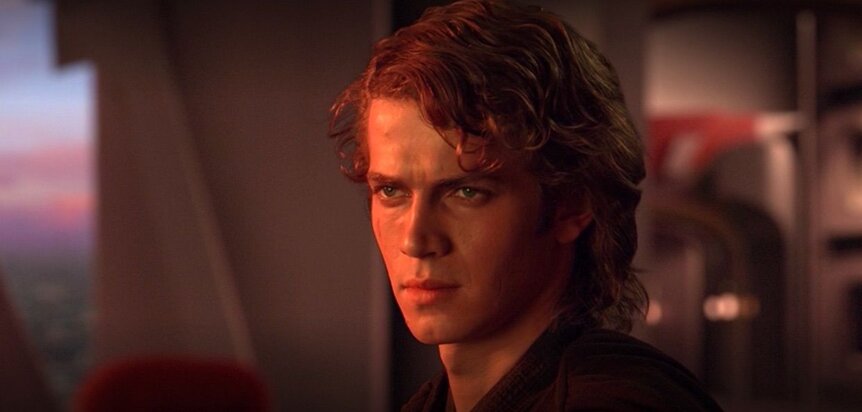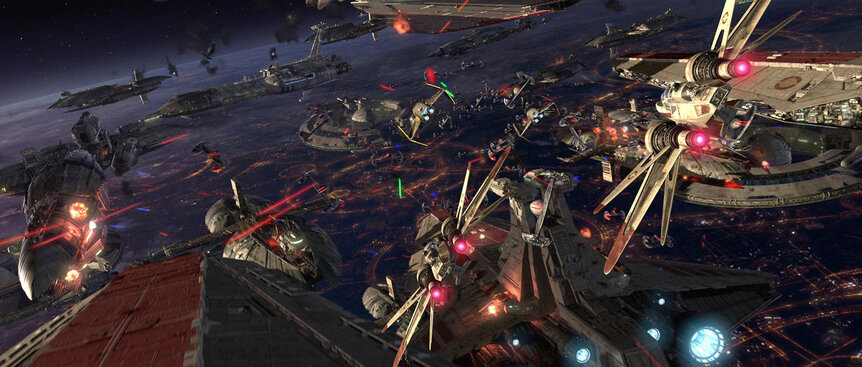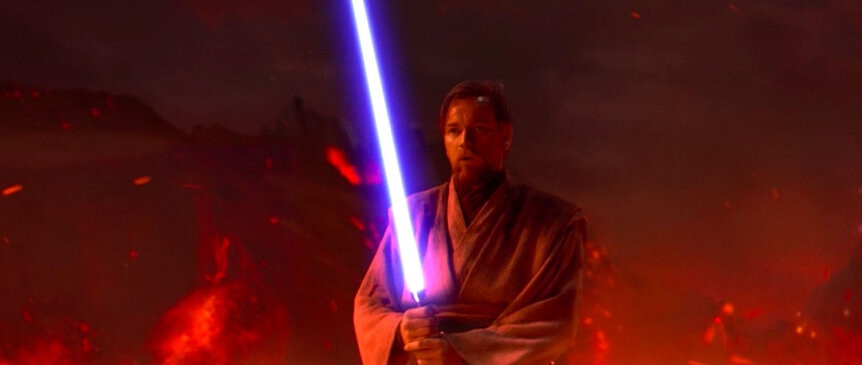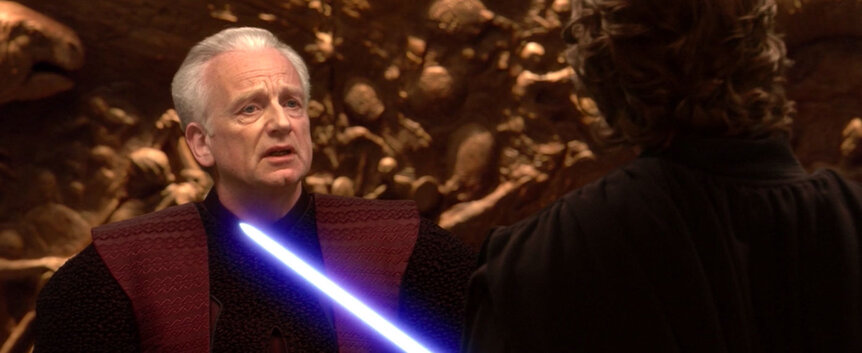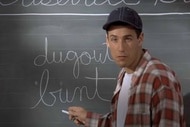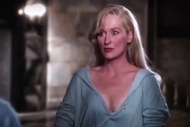Create a free profile to get unlimited access to exclusive videos, sweepstakes, and more!
Why Revenge of the Sith is undoubtedly the best Star Wars trilogy ender
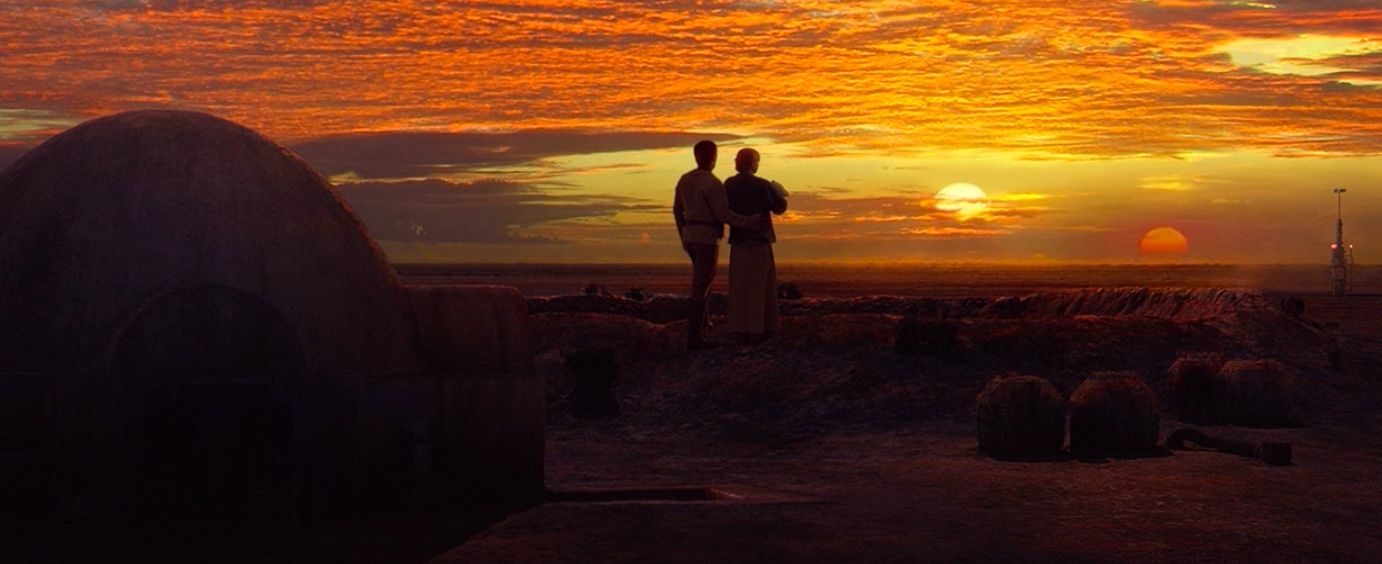
Of the three Star Wars trilogies, two of them end in the exact same spot: in the desert, with people staring out into the twin suns of Tatooine. Star Wars: The Rise of Skywalker was clearly referencing the iconic binary sunset from the first act of A New Hope — but the final scene of Star Wars: Revenge of the Sith did this homage first. And, arguably, better.
In fact, of all three Star Wars trilogies, the prequels easily have the best final installment with Revenge of the Sith, which premiered 15 years ago today, May 19. Saying that Revenge of the Sith is the best Star Wars movie ever would be borderline insane, but if its primary job was to wrap up the storylines and plot points in the previous two films in its trilogy, then Revenge of the Sith beats both Star Wars: Return of the Jedi and The Rise of Skywalker any day of the week. Here's why.
THE STORY
One huge advantage Revenge of the Sith has over Return of the Jedi and The Rise of Skywalker is that it's the only Star Wars trilogy-ender that didn't need to have a happy conclusion. In fact, having a dark and depressing third act was pretty much a prerequisite for Revenge of the Sith to make sense. Because Episode III had to end with Anakin Skywalker having turned to the dark side of the Force, most of the Jedi dead, and the Empire ascendant, the upbeat glimmer of hope we associate with most endings of Star Wars films wasn't necessary or welcome. Sure, Revenge of the Sith telegraphed out a hopeful ending — look, here's Obi-Wan handing baby Luke Skywalker to Uncle Owen and Aunt Beru — but it's still a little somber. There's no dialogue in that last sequence, just music. Which, in some ways, sums up the entirety of Revenge of the Sith.
THE MUSIC
Imagine watching Return of the Jedi or The Rise of Skywalker on mute and totally without subtitles. It would probably be impossible. Both of those films are saddled with so much talky exposition that it would actually be fairly tricky to figure out what the hell was going on unless you were told. From complicated plots about shield generators to confusing revelations about who is related to who, Return of the Jedi and The Rise of Skywalker tell much more than they show. This also works if you flip it: Pretend you had no visuals (and still no dialogue) and you could only listen to the John Williams music for Return of the Jedi or The Rise of Skywalker as though you were listening to an opera without language. Again, you'd get some great motifs and moments, but I'm not sure that music tells a complete and tonally consistent story.
Williams' music for Revenge of the Sith does a better job at telling a story than any of his other scores for Star Wars, with the possible exception of Star Wars: The Empire Strikes Back. Part of the reason is variety. No other Star Wars movie has music quite like "Palpatine's Teachings" and "Padmé's Ruminations." These are droning, low numbers that feel closer to what you might expect in Blade Runner 2049 or in an episode of Westworld. They're trippy, weird, and dark, and they certainly tell a story. There's not a dud on the entire Sith soundtrack, and the same can't be said of the generic The Rise of Skywalker or of Return of the Jedi, which features the infamous Ewok "Yub Nub" song.
But the other reason is that in Revenge of the Sith, Williams deploys the really familiar Star Wars themes (like "The Imperial March") only when he needs them. The rest of the time, the music is fairly specific to this film and this film only. The music that scores Anakin and Obi-Wan's big fight — "Battle of the Heroes" — is one of the most underrated and also smartly understated pieces of Star Wars music ever. Look, it's not "Duel of the Fates," and because of that, it will forever live in the shadow of "Duel of the Fates," particularly because in the film, "Duel of the Fates" is unnecessarily spliced in alongside "Battle of the Heroes."
And yet, the thing that makes "Battle of the Heroes" slap so hard is that it feels like a track that is specific to these characters at this particular moment. Because so many Star Wars musical motifs and themes are recycled throughout the saga, it's hard to say that about any other piece of Star Wars music.
THE LOOK
Visually, the color palette and the overall art direction of Revenge of the Sith looks amazing. True, it's hard to beat Luke Skywalker and Darth Vader's duel in Return of the Jedi, but relative to the classic trilogy, that was simply a rematch. Visually, what you're seeing isn't that different from Empire. On some level, the lightsaber battle that ends Return of the Jedi is fairly forgettable because it's just the reverse of the same lightsaber battle in Empire, only this time, you've got a jerk in the background laughing. Ditto for Rise of Skywalker, which cribs from Return of the Jedi so obscenely that some of Palpatine's dialogue is the same.
Obi-Wan and Anakin's battle of the heroes on Mustafar isn't like any of the lightsaber duels in any other Star Wars movie, and the entire sequence — regardless of how you feel about "the high ground" — tells a story and is ridiculously unique. George Lucas also collaborated with Steven Spielberg to craft the animatics to help map out the Mustafar lightsaber duel. Spielberg did the same for Obi-Wan's ridiculously cool chase sequence against General Grievous, which featured Obi-Wan riding a friendly dragon while Grievous scoots around on a super-complicated circular speeder bike. These two scenes alone have literally no equals in any other Star Wars film. I'm not saying Obi-Wan's goofy dragon is better than other scenes in Star Wars, simply that there's nothing in Revenge of the Sith that looks like things in other films.
According to several reports, one of Lucas' biggest issues with Star Wars: The Force Awakens — and the new trilogy in general — is that they didn't really do anything new, at least visually. And while you could say he was wrong in certain areas (Star Wars: The Last Jedi looks pretty different), it's hard to argue that Revenge of the Sith didn't push the envelope.
General Grievous' absurd four-armed lightsaber action, the stunning opening shot over the planet Coruscant, the powerful montage in which all the Jedi are taken down by Order 66 — most shots in Revenge of the Sith belong to this movie exclusively. Keep in mind that Revenge of the Sith gets criticized for its reliance on green screen, but the boldness of the green screen in Sith gives the movie its baroque, over-the-top quality. It's not like J.J. Abrams used zero green screens in that final Rise of Skywalker lightsaber duel. The difference is Lucas decided to make a crazy lava planet and Abrams did whatever it is he did with that stone planet.
SHAKESPEAREAN TRAGEDY
Dialogue isn't Revenge of the Sith's strongest suit, but that's OK because it's probably the least important aspect of the film, given the inevitability of the story at this point. The plotting is relentlessly efficient, to the point where you might find yourself wishing scenes were longer — something that can't be said for the first two prequels. It's a film that is a little stilted and melodramatic for people who like the slick, sexy, and artistically perfect The Empire Strikes Back. But, appropriately, Revenge of the Sith also pulled off something its two predecessors didn't do: It felt like a period piece relative to the rest of Star Wars.
The goal of the prequel trilogy was to give us a glimpse at what Obi-Wan was talking about when he mentioned "a more civilized age" in A New Hope. In Revenge of the Sith, the entire feeling of the movie turns Star Wars into a kind of Shakespearean tragedy. Hayden Christensen isn't bad in Revenge of the Sith, and that's because he's playing this out like he's in a production of Hamlet. And he's not playing Hamlet for people who are looking at him through a microscope. He's doing it for the people in the cheap seats. He's going big so you get it. This is a tragedy.
Christensen, along with Ian McDiarmid, Natalie Portman, Ewan McGregor, and Samuel L. Jackson, go big and go broad in Revenge of the Sith. And, for all of them other than McDiarmid, this would be their very last Star Wars movie. Unlike the endings of Return of the Jedi and The Rise of Skywalker, the character arcs of Anakin Skywalker, Padmé Amidala, Obi-Wan Kenobi, Mace Windu, Yoda, and, yes, Palpatine, pretty much end.
Sure, some of this is because a few of these characters die, but you're not confused about where anyone is or what is going to happen. Some of this is by design: Revenge of the Sith is a prequel to A New Hope. But, at the time it was released, it was also intended to be the final Star Wars movie ever. And its conclusionary vibe shows that Lucas wasn't kidding around at the time, either; unlike either final film in the other trilogies, Revenge of the Sith either murders its characters or ends their stories in such a way that when they reappear in other films, they are fundamentally not the same characters.
It should also be noted that, of all of his films, Sith is easily the one that defines McDiarmid's talents relative to Star Wars. Fans might enjoy the cackling super-lightning Palpatine in Rise of Skywalker, but the Palpatine of Revenge of the Sith is scarier and better.
Unlike any Star Wars movie before or since, Revenge of the Sith is the only time when Star Wars suggested that big stories have sad endings. When Sith closed down the prequel trilogy, it did so with real and deeply tragic stakes. After all, you can't have scary bad guys unless, sometimes, they win.
And unlike the cliffhanger of The Empire Strikes Back, the finality of Revenge of the Sith makes an even stronger statement: Not only did the bad guys win this time, but it's also going to take about 20 years to get rid of them.
Just like Palpatine said: That's power — unlimited power.
